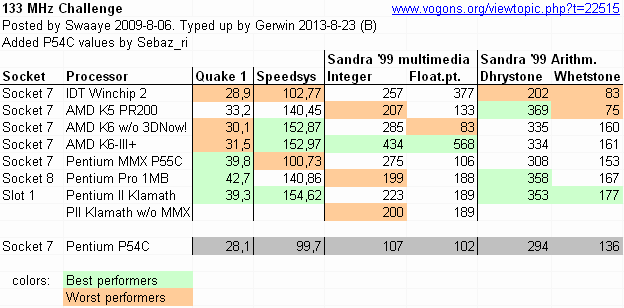First post, by swaaye
- Rank
- l33t++
I thought it would be interesting to run a bunch of CPUs at 133 MHz and compare them at that speed. Comparative per-clock performance.
Socket 7 platform (Winchip, P55C, K5, K6, K6-III+)
- ASUS P5A mobo
- 128MB PC133 SDRAM 2-2-2 1:1 with FSB
- STB Nitro 3D Virge GX 4MB PCI
Socket 8 platform (Pentium Pro 1MB)
- Intel VS440FX mobo
- 128MB 60ns EDO DRAM
- STB Nitro 3D Virge GX 4MB PCI
Slot 1 platform (Pentium II "Klamath")
- Supermicro P6SKE 440FX mobo
- 128MB 60ns EDO DRAM
- STB Nitro 3D Virge GX 4MB PCI
Tests: Quake software mode (timedemo demo2), Sandra 2002, Speedsys 4.70
Notes:
For graphics on both systems, S3VBE20 and S3SPDUP were used to optimize the video card. FastVid was used to optimize 440FX and PPro/PII. For CPU features, the K6 has write allocate enabled via BIOS and the K5 has it enabled through software utils. No BIOS changes were made between CPUs.
I wanted to use K6-2 as well but I forgot that the 2x multiplier is remapped to 6x on CXT cores. I also would've liked to have a Pentium Classic in there but I don't have one that will do 133 MHz. Also have no Cyrix CPUs.
Comments on the results:
Quake is definitely best played on a Pentium or PPro/PII. They dust the competition per-clock. Pentium Pro is the fastest Quake CPU of the challengers. P6's FPU is superior to everyone else's in everything.
K5 actually bests K6 in some tests. It's faster at Quake! The K6-III+ only shows tangible improvement over K6 when 3DNow! or MMX are used.
WinChip's simple in-order architecture is not that great when it can't run SIMD code. And it isn't as good at MMX / 3DNow! as the competitors that have it too.
Result spreadsheet courtesy of Gerwin.
P54C results from Sebaz_ri
